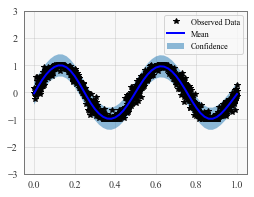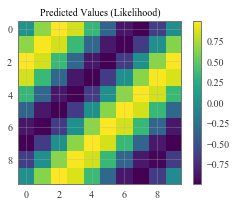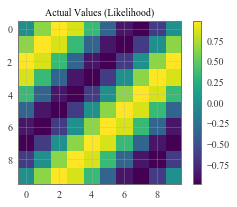Structured Kernel Interpollation (SKI/KISS-GP)¶
Overview¶
SKI (or KISS-GP) is a great way to scale a GP up to very large datasets (100,000+ data points). Kernel interpolation for scalable structured Gaussian processes (KISS-GP) was introduced in this paper: http://proceedings.mlr.press/v37/wilson15.pdf
SKI is asymptotically very fast (nearly linear), very precise (error decays cubically), and easy to use in GPyTorch! As you will see in this tutorial, it’s really easy to apply SKI to an existing model. All you have to do is wrap your kernel module with a GridInterpolationKernel.
[1]:
import math
import torch
import gpytorch
from matplotlib import pyplot as plt
# Make plots inline
%matplotlib inline
KISS-GP for 1D Data¶
Set up training data¶
We’ll learn a simple sinusoid, but with lots of training data points. At 1000 points, this is where scalable methods start to become useful.
[2]:
train_x = torch.linspace(0, 1, 2000)
train_y = torch.sin(train_x * (4 * math.pi) + torch.randn(train_x.size()) * 0.2)
Set up the model¶
The model should be somewhat similar to the ExactGP model in the simple regression example.
The only difference: we’re wrapping our kernel module in a GridInterpolationKernel. This signals to GPyTorch that you want to approximate this kernel matrix with SKI.
SKI has only one hyperparameter that you need to worry about: the grid size. For 1D functions, a good starting place is to use as many grid points as training points. (Don’t worry - the grid points are really cheap to use!). You can use the gpytorch.utils.grid.choose_grid_size helper to get a good starting point.
If you want, you can also explicitly determine the grid bounds of the SKI approximation using the grid_bounds argument. However, it’s easier if you don’t use this argument - then GPyTorch automatically chooses the best bounds for you.
[7]:
class GPRegressionModel(gpytorch.models.ExactGP):
def __init__(self, train_x, train_y, likelihood):
super(GPRegressionModel, self).__init__(train_x, train_y, likelihood)
# SKI requires a grid size hyperparameter. This util can help with that. Here we are using a grid that has the same number of points as the training data (a ratio of 1.0). Performance can be sensitive to this parameter, so you may want to adjust it for your own problem on a validation set.
grid_size = gpytorch.utils.grid.choose_grid_size(train_x,1.0)
self.mean_module = gpytorch.means.ConstantMean()
self.covar_module = gpytorch.kernels.ScaleKernel(
gpytorch.kernels.GridInterpolationKernel(
gpytorch.kernels.RBFKernel(), grid_size=grid_size, num_dims=1
)
)
def forward(self, x):
mean_x = self.mean_module(x)
covar_x = self.covar_module(x)
return gpytorch.distributions.MultivariateNormal(mean_x, covar_x)
likelihood = gpytorch.likelihoods.GaussianLikelihood()
model = GPRegressionModel(train_x, train_y, likelihood)
Train the model hyperparameters¶
Even with 1000 points, this model still trains fast! SKI scales (essentially) linearly with data - whereas standard GP inference scales quadratically (in GPyTorch.)
[8]:
# this is for running the notebook in our testing framework
import os
smoke_test = ('CI' in os.environ)
training_iterations = 2 if smoke_test else 30
# Find optimal model hyperparameters
model.train()
likelihood.train()
# Use the adam optimizer
optimizer = torch.optim.Adam(model.parameters(), lr=0.1) # Includes GaussianLikelihood parameters
# "Loss" for GPs - the marginal log likelihood
mll = gpytorch.mlls.ExactMarginalLogLikelihood(likelihood, model)
for i in range(training_iterations):
optimizer.zero_grad()
output = model(train_x)
loss = -mll(output, train_y)
loss.backward()
optimizer.step()
Make predictions¶
SKI is especially well-suited for predictions. It can comnpute predictive means in constant time, and with LOVE enabled (see this notebook), predictive variances are also constant time.
[10]:
# Put model & likelihood into eval mode
model.eval()
likelihood.eval()
# Initalize plot
f, ax = plt.subplots(1, 1, figsize=(4, 3))
# The gpytorch.settings.fast_pred_var flag activates LOVE (for fast variances)
# See https://arxiv.org/abs/1803.06058
with torch.no_grad(), gpytorch.settings.fast_pred_var():
test_x = torch.linspace(0, 1, 51)
prediction = likelihood(model(test_x))
mean = prediction.mean
# Get lower and upper predictive bounds
lower, upper = prediction.confidence_region()
# Plot the training data as black stars
def ax_plot():
if smoke_test: return # this is for running the notebook in our testing framework
ax.plot(train_x.detach().numpy(), train_y.detach().numpy(), 'k*')
# Plot predictive means as blue line
ax.plot(test_x.detach().numpy(), mean.detach().numpy(), 'b')
# Plot confidence bounds as lightly shaded region
ax.fill_between(test_x.detach().numpy(), lower.detach().numpy(), upper.detach().numpy(), alpha=0.5)
ax.set_ylim([-3, 3])
ax.legend(['Observed Data', 'Mean', 'Confidence'])
ax_plot()

KISS-GP for 2D-4D Data¶
For 2-4D functions, SKI (or KISS-GP) can work very well out-of-the-box on larger datasets (100,000+ data points). Kernel interpolation for scalable structured Gaussian processes (KISS-GP) was introduced in this paper: http://proceedings.mlr.press/v37/wilson15.pdf
One thing to watch out for with multidimensional SKI - you can’t use as fine-grain of a grid. If you have a high dimensional problem, you may want to try one of the other scalable regression methods.
Set up train data¶
Here we’re learning a simple sin function - but in 2 dimensions
[11]:
# We make an nxn grid of training points spaced every 1/(n-1) on [0,1]x[0,1]
n = 40
train_x = torch.zeros(pow(n, 2), 2)
for i in range(n):
for j in range(n):
train_x[i * n + j][0] = float(i) / (n-1)
train_x[i * n + j][1] = float(j) / (n-1)
# True function is sin( 2*pi*(x0+x1))
train_y = torch.sin((train_x[:, 0] + train_x[:, 1]) * (2 * math.pi)) + torch.randn_like(train_x[:, 0]).mul(0.01)
The model¶
As with the 1D case, applying SKI to a multidimensional kernel is as simple as wrapping that kernel with a GridInterpolationKernel. You’ll want to be sure to set num_dims though!
SKI has only one hyperparameter that you need to worry about: the grid size. For 1D functions, a good starting place is to use as many grid points as training points. (Don’t worry - the grid points are really cheap to use!). You can use the gpytorch.utils.grid.choose_grid_size helper to get a good starting point.
If you want, you can also explicitly determine the grid bounds of the SKI approximation using the grid_bounds argument. However, it’s easier if you don’t use this argument - then GPyTorch automatically chooses the best bounds for you.
[14]:
class GPRegressionModel(gpytorch.models.ExactGP):
def __init__(self, train_x, train_y, likelihood):
super(GPRegressionModel, self).__init__(train_x, train_y, likelihood)
# SKI requires a grid size hyperparameter. This util can help with that
grid_size = gpytorch.utils.grid.choose_grid_size(train_x)
self.mean_module = gpytorch.means.ConstantMean()
self.covar_module = gpytorch.kernels.ScaleKernel(
gpytorch.kernels.GridInterpolationKernel(
gpytorch.kernels.RBFKernel(), grid_size=grid_size, num_dims=2
)
)
def forward(self, x):
mean_x = self.mean_module(x)
covar_x = self.covar_module(x)
return gpytorch.distributions.MultivariateNormal(mean_x, covar_x)
likelihood = gpytorch.likelihoods.GaussianLikelihood()
model = GPRegressionModel(train_x, train_y, likelihood)
Train the model hyperparameters¶
[15]:
# Find optimal model hyperparameters
model.train()
likelihood.train()
# Use the adam optimizer
optimizer = torch.optim.Adam(model.parameters(), lr=0.1) # Includes GaussianLikelihood parameters
# "Loss" for GPs - the marginal log likelihood
mll = gpytorch.mlls.ExactMarginalLogLikelihood(likelihood, model)
def train():
for i in range(training_iterations):
optimizer.zero_grad()
output = model(train_x)
loss = -mll(output, train_y)
loss.backward()
optimizer.step()
%time train()
CPU times: user 57.8 s, sys: 847 ms, total: 58.7 s
Wall time: 10.5 s
Make predictions with the model¶
[16]:
# Set model and likelihood into evaluation mode
model.eval()
likelihood.eval()
# Generate nxn grid of test points spaced on a grid of size 1/(n-1) in [0,1]x[0,1]
n = 10
test_x = torch.zeros(int(pow(n, 2)), 2)
for i in range(n):
for j in range(n):
test_x[i * n + j][0] = float(i) / (n-1)
test_x[i * n + j][1] = float(j) / (n-1)
with torch.no_grad(), gpytorch.settings.fast_pred_var():
observed_pred = likelihood(model(test_x))
pred_labels = observed_pred.mean.view(n, n)
# Calc abosolute error
test_y_actual = torch.sin(((test_x[:, 0] + test_x[:, 1]) * (2 * math.pi))).view(n, n)
delta_y = torch.abs(pred_labels - test_y_actual).detach().numpy()
# Define a plotting function
def ax_plot(f, ax, y_labels, title):
if smoke_test: return # this is for running the notebook in our testing framework
im = ax.imshow(y_labels)
ax.set_title(title)
f.colorbar(im)
# Plot our predictive means
f, observed_ax = plt.subplots(1, 1, figsize=(4, 3))
ax_plot(f, observed_ax, pred_labels, 'Predicted Values (Likelihood)')
# Plot the true values
f, observed_ax2 = plt.subplots(1, 1, figsize=(4, 3))
ax_plot(f, observed_ax2, test_y_actual, 'Actual Values (Likelihood)')
# Plot the absolute errors
f, observed_ax3 = plt.subplots(1, 1, figsize=(4, 3))
ax_plot(f, observed_ax3, delta_y, 'Absolute Error Surface')



KISS-GP for higher dimensional data w/ Additive Structure¶
The method above won’t scale to data with much more than ~4 dimensions, since the cost of creating the grid grows exponentially in the amount of data. Therefore, we’ll need to make some additional approximations.
If the function you are modeling has additive structure across its dimensions, then SKI can be one of the most efficient methods for your problem.
To set this up, we’ll wrap the GridInterpolationKernel used in the previous two models with one additional kernel: the AdditiveStructureKernel. The model will look something like this:
[17]:
class GPRegressionModel(gpytorch.models.ExactGP):
def __init__(self, train_x, train_y, likelihood):
super(GPRegressionModel, self).__init__(train_x, train_y, likelihood)
# SKI requires a grid size hyperparameter. This util can help with that
# We're setting Kronecker structure to False because we're using an additive structure decomposition
grid_size = gpytorch.utils.grid.choose_grid_size(train_x, kronecker_structure=False)
self.mean_module = gpytorch.means.ConstantMean()
self.covar_module = gpytorch.kernels.AdditiveStructureKernel(
gpytorch.kernels.ScaleKernel(
gpytorch.kernels.GridInterpolationKernel(
gpytorch.kernels.RBFKernel(), grid_size=128, num_dims=1
)
), num_dims=2
)
def forward(self, x):
mean_x = self.mean_module(x)
covar_x = self.covar_module(x)
return gpytorch.distributions.MultivariateNormal(mean_x, covar_x)
likelihood = gpytorch.likelihoods.GaussianLikelihood()
model = GPRegressionModel(train_x, train_y, likelihood)
Essentially, the AdditiveStructureKernel makes the base kernel (in this case, the GridInterpolationKernel wrapping the RBFKernel) to act as 1D kernels on each data dimension. The final kernel matrix will be a sum of these 1D kernel matrices.
Scaling to more dimensions (without additive structure)¶
If you can’t exploit additive structure, then try one of these other two methods:
KISS-GP with Deep Kernel Learning